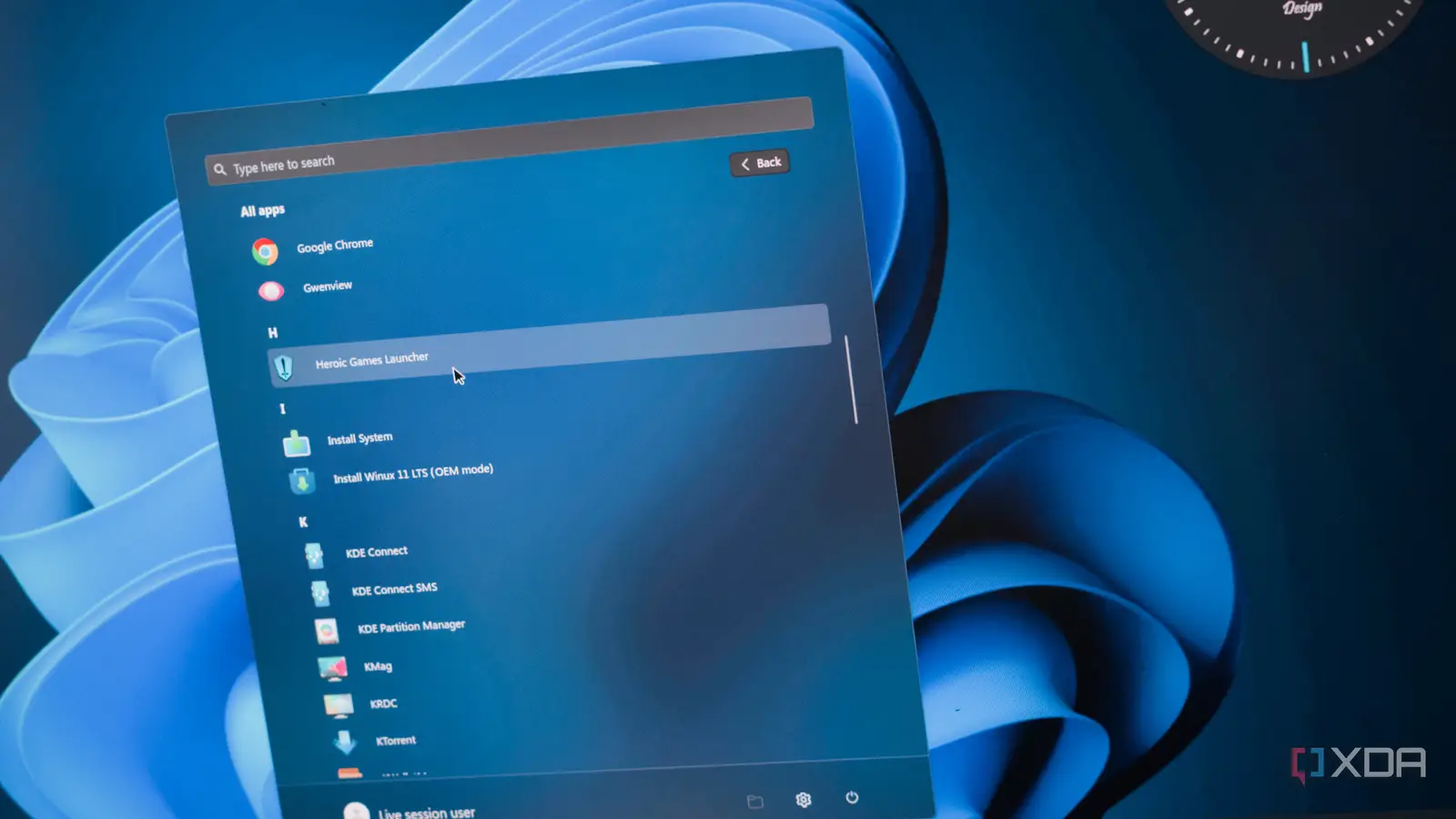
Tired of Windows 11 but want to keep using a desktop operating system that resembles Microsoft’s design language? There are a few choices available within the Linux community. You have the option of using a tailor-made distro with all the necessary bells and whistles preinstalled, or you can choose one of the many available to serve as a solid and secure foundation for creating your own Windows-like Linux-powered OS. What you shouldn’t do, however, is use Winux. I downloaded this OS after seeing it covered by esteemed publications, and I’m struggling to see the appeal.
Then there’s the chequered history of this distro’s development. Heard of Linuxfx and Wubuntu? Winux is essentially the same deal but an updated effort with a flashier website. Is it worth your time? Probably not.
Linux’s openness is a blessing
But it can also be a curse if you’re not careful
One of the best parts about Linux is its open nature. You can craft an OS that matches your precise needs and requirements with a little know-how and some free time. It’s also why we have so many distros. Want something easy to get started with after migrating from macOS or Windows? Ubuntu, Linux Mint, and Pop! OS is likely your best bet, but there are still countless others I could recommend. Do you need something a little more basic for advanced usage? Arch Linux and NixOS are good starting points.
Trying to bring as many commercial features across to an open-source platform can be viewed as contradictory to the Linux ethos.
That’s what makes the Linux ecosystem so vibrant and active. There’s something for everyone, and it only takes a couple of minutes to contribute to a project, be it donating or even supplying bug fixes and code changes. But because it’s incredibly accessible for those with at least a little experience, you can come across lesser-known distros that aren’t quite up to par with the more popular counterparts. One such example was LinuxFX, which launched in 2007. It was a seemingly innocent distro that attempted to mimic Windows 7.
While this alone wouldn’t cause much of a concern, outside of potential copyright infringement, depending on how aggressive the copying was from Microsoft’s OS, it ended up being quite the quirky OS and not in all the right ways. It was reported in 2022 that the database containing all the details for online registration and activation — yes, they even copied that across from Windows — was compromised and available for all to see. Data contained within the database included IP addresses, license keys, and email addresses. Kernal did some epic investigative work on the OS.
The team managed to dump the database and even provide a key that allowed for an unlimited number of activations on LinuxFX. Not a great start. Instead of fixing the problem, the developer kept the insecure solution up and running, and even found the time to reportedly replace the existing database URL with a plaintext file containing slurs such as “kernalisdumb” and “kernalislammer.” Finally, these were reported to have been replaced by some other text, resulting in the analysis that LinuxFX was completely compromised.
So, how about Wubuntu? Well, Wubuntu was (or is?) LinuxFX. It’s simply another name for the same OS developed by the same individual. That’s not to suggest the rest of these distros were bad, but trying to bring as many commercial features across to an open-source platform can be viewed as contradictory to the Linux ethos. Wubuntu faced backlash for cluttering the desktop and including unnecessary design elements. ZDNet previously recommended Wubuntu and subsequently pulled their support entirely once digging a little deeper, suggesting Zorin OS as a replacement. (It’s a legit distro.)
The problem with “Windows-like” distros
Looking like Windows is not a substitute for a powerful distro
Making Linux look like Windows isn’t inherently bad and can lead to better transitions for those used to the way Microsoft does things. It’s easier for those more tech-savvy to hop between operating systems and even make the move from Windows to Linux, but those with fewer hours in front of a PC may find it notably more jarring. That’s where a distro such as Zorin OS, Linux Mint, or even Kubuntu comes into play. They won’t look identical to Windows, but they come close enough to make the switch easier.
The issue comes with Windows-like distros, such as Wubuntu, LinuxFX, and Winux. I’ve never found these distros enticing, replicating Microsoft’s OS. There’s a reason I moved from Windows and Microsoft’s invasive anti-consumer practices. I don’t wish to see them plague my open-source system, too. But others may find them useful, and as such, we’ve even covered a few distros right here at XDA for those who desire an easier time switching from Windows and wouldn’t want something too alien to their computing experiences.
Another great part about using Linux is knowing the underlying technologies are robust and community-developed. When booting up Arch Linux for the first time, you’re experiencing a raw Linux OS without the usual desktop environment, unless otherwise desired. For Ubuntu, you know it has been developed well, cross-checked, and verified by various parties, including those from within Canonical. The same goes for Linux Mint, Fedora, Red Hat, and other distros. But for smaller distros with potentially one or two developers, things get a little murky.
The issue comes with Windows-like distros, such as Wubuntu, LinuxFX, and Winux. I’ve never found these distros enticing, replicating Microsoft’s OS.
If you’re not familiar with how Linux works, don’t know what to look for with the underlying OS, and have very little experience with how everything interconnects, it’s easy to miss some glaring red flags. The same goes for Windows with custom images. You’re placing a fair amount of trust in the hands of some unknown individuals, and that’s perfectly fine for running the OS in an isolated environment, but if you decide to go all in and load up your banking, personal, and sensitive data onto the system, you run the risk of something going terribly wrong.
Winux isn’t the answer
There are better distros
On the surface, this may seem like an innocent Linux distro with a flashy website and a quick introductory video. You’ve got a solid KDE underpinnings, a Windows-like theme, and some icons to make the OS resemble Windows 11. MissionCenter replaces KDE’s System Monitor with a Task Manager-style resource monitor experience. HardInfo is included to provide details on connected hardware, though something already exists within KDE. “Driver Manager” is similar to Ubuntu’s handling of proprietary and open source drivers, so nothing really new there.
The highlight feature of Winux is PowerTools, which is stated to control various parts of the OS:
Appearance and control of Windows-inspired themes.
Windows-style Control Panel and Settings.
Improved support for .exe and .msi applications.
Active Directory graphical support.
Native graphics support for OneDrive.
Native OneDrive in File Explorer.
Android Subsystem (with graphics acceleration).
PowerTools security and enhancement updates.
Improvements to the Copilot and ChatGPT subsystem.
The only downside to this is that a lifetime charge of $35 is required to gain access to it. This takes us back to the same issues with LinuxFX and Wubuntu. It’s the same OS all over again, and sure, the developer may have learned a thing or two along the way, but it’s difficult to recommend a distro marred in controversy and charging for features. Zorin OS is commercial and does have an optional purchase, but this comes with plenty of tools and optional extras that can resemble Windows better.
Or if you’ve reached this point already, you could simply purchase a Windows license? We need to stop recommending a tight walk for Windows converts moving to Linux. If they wish to leap Microsoft’s camp, they should run through the brief gauntlet of FOSS. If I were writing this a decade ago, my thoughts may have differed since distros weren’t nearly as polished as they are now. I recall system instability and just a general lack of attention to detail in favor of the underlying technology.
Linux (and the plethora of distros available today) gets this balance right, and I believe any of the more popular choices would make a great alternative to Windows. Ready to get started? Boot up a live environment and you can try Linux without making a single change to your Windows PC.



